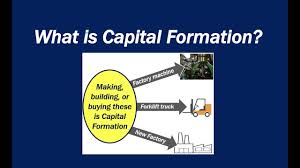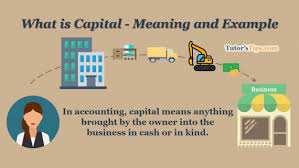
What is Capital?
In economics, capital consists of assets that can enhance one’s power to perform economically useful work. For example, a stone or an arrow is capital for a hunter-gatherer who can use it as a hunting instrument; similarly, roads are capital for inhabitants of a city.
Capital is a term for financial assets, such as funds held in deposit accounts and/or funds obtained from special financing sources. Capital can also be associated with capital assets of a company that requires significant amounts of capital to finance or expand.
Capital can be held through financial assets or raised from debt or equity financing. Businesses will typically focus on three types of business capital: working capital, equity capital, and debt capital. In general, business capital is a core part of running a business and financing capital intensive assets.
Capital assets are asset of a business found on either the current or long-term portion of the balance sheet. Capital assets can include cash, cash equivalents, and marketable securities as well as manufacturing equipment, production facilities, and storage facilities.
 Understanding Capital
Understanding Capital
From a financial capital economics perspective, capital is a key part of running a business and growing an economy. Companies have capital structures that include debt capital, equity capital, and working capital for daily expenditures. Individuals hold capital and capital assets as part of their net worth. How individuals and companies finance their working capital and invest their obtained capital is critical for growth and return on investment.
Capital is typically cash or liquid assets held or obtained for expenditures. In financial economics, the term may be expanded to include a company’s capital assets. In general, capital can be a measurement of wealth and also a resource that provides for increasing wealth through direct investment or capital project investments.
Capital is used to provide ongoing production of goods and services for creating profit. Companies use capital to invest in all kinds of things for the purpose of creating value for a firm. Labor and building expansions can be two areas where capital is often allocated. By investing through the use of capital, a business or individual directs their money toward investments that earn a higher return than the capital’s costs.
The financial capital economics definition can be analyzed by economists to understand how capital in the economy is influencing economic growth. Economists watch several metrics of capital including personal income and personal consumption from the Commerce Department’s Personal Income and Outlays reports as well as investment found in the quarterly Gross Domestic Product report.
Typically, business capital and financial capital are viewed from the perspective of a company’s capital structure. In the United States, banks are required to hold a specified amount of capital as a risk mitigation requirement as directed by the central banks and banking regulations. Other private companies have the responsibility of assessing their own capital thresholds, capital assets, and capital needs for corporate investment.
Business Capital Structure
Businesses need a substantial amount of capital to operate and create profitable returns. Balance sheet analysis is central to the review and assessment of business capital. Split between assets, liabilities, and equity, a company’s balance sheet provides for metric analysis of a capital structure. Debt financing provides a cash capital asset that must be repaid over time through scheduled liabilities. Equity financing provides cash capital that is also reported in the equity portion of the balance sheet with an expectation of return for the investing shareholders. Debt capital typically comes with lower relative rates of return alongside strict provisions for repayment. Some of the key metrics for analyzing business capital include weighted average cost of capital, debt to equity, debt to capital, and return on equity.
 Types of Capital
Types of Capital
Here are the top four types of capital in more detail:
Debt Capital
A business can acquire capital through the assumption of debt. Debt capital can be obtained through private or government sources. Sources of capital can include friends, family, financial institutions, online lenders, credit card companies, insurance companies, and federal loan programs.
Individuals and companies must typically have an active credit history to obtain debt capital. Debt capital requires regular repayment with interest. Interest will vary depending on the type of capital obtained and the borrower’s credit history.
Equity Capital
Equity capital can come in several forms. Typically distinctions are made between private equity, public equity, and real estate equity. Private and public equity will usually be structured in the form of shares. Public equity capital raises occur when a company lists on a public market exchange and receives equity capital from shareholders. Private equity is not raised in the public markets. Private equity usually comes from select investors or owners
Working Capital
Working capital includes a company’s most liquid capital assets available for fulfilling daily obligations. It is calculated on a regular basis through the following two assessments:
Current Assets – Current Liabilities
Accounts Receivable + Inventory – Accounts Payable
Working capital measures a company’s short-term liquidity—more specifically, its ability to cover its debts, accounts payable, and other obligations that are due within one year.
Trading Capital
Trading capital may be held by individuals or firms who place a large number of trades on a daily basis. Trading capital refers to the amount of money allotted to buy and sell various securities.
Investors may attempt to add to their trading capital by employing a variety of trade optimization methods. These methods attempt to make the best use of capital by determining the ideal percentage of funds to invest with each trade. In particular, to be successful, it is important for traders to determine the optimal cash reserves required for their investing strategies.
Capital vs. Money
At its core, capital is money. However, for financial and business purposes capital is typically viewed from an operational and investment perspective. Capital usually comes with a cost. For debt capital, this is the cost of interest required in repayment. For equity capital, this is the cost of distributions made to shareholders. Overall, capital is deployed to help shape a company’s development and growth.
Financial and Business expert having 30+ Years of vast experience in running successful businesses and managing finance.






